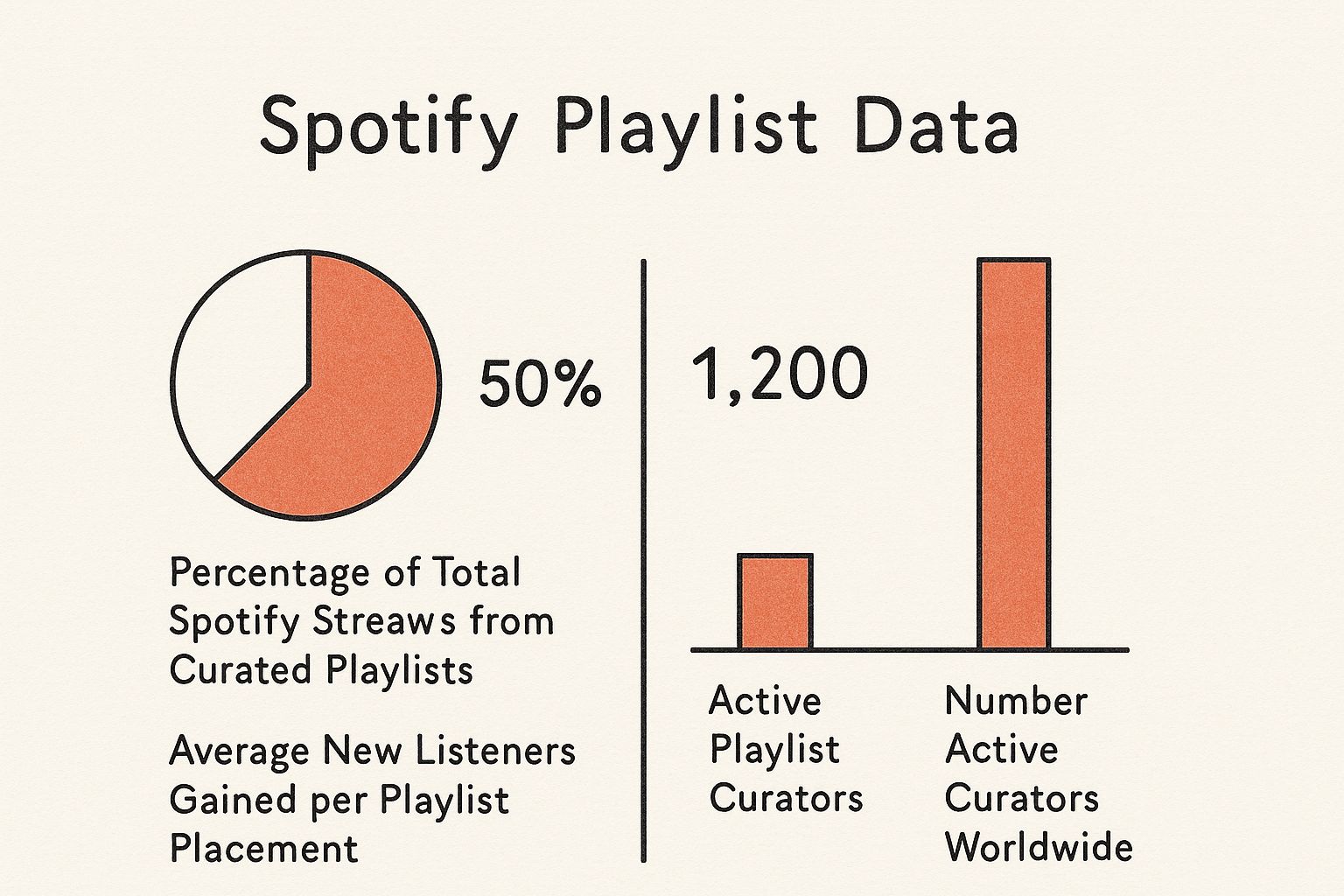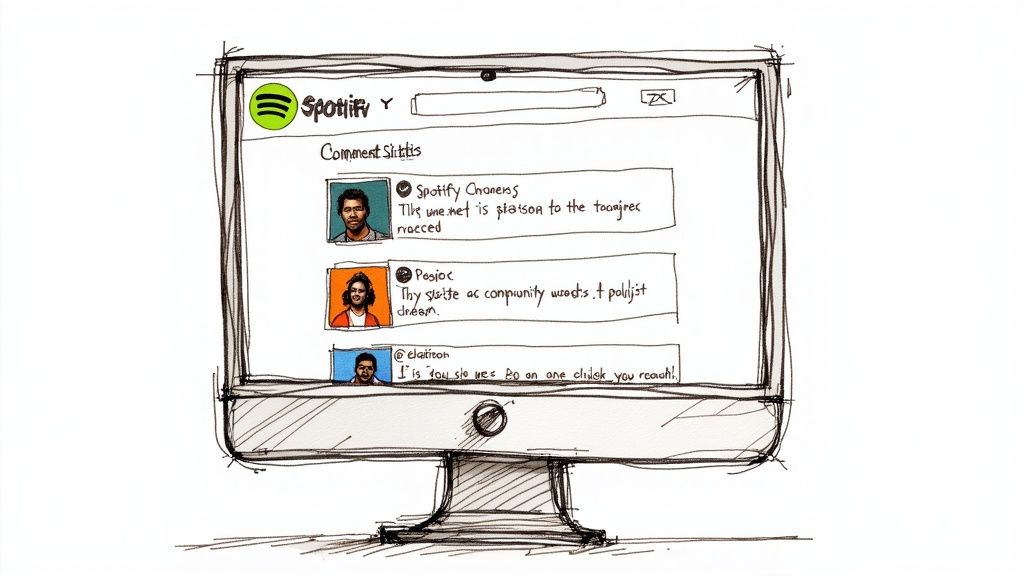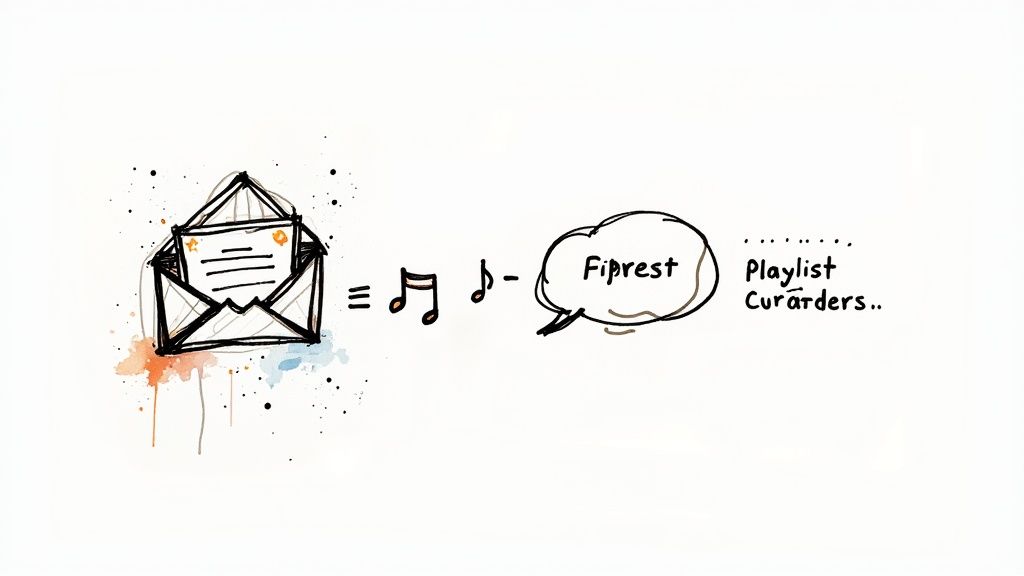How To Find Spotify Playlist Curators: Complete Guide
- jesseee14
- Jun 4, 2025
- 12 min read
Understanding The Spotify Playlist Landscape
Navigating the world of Spotify playlists can feel overwhelming. With millions of playlists competing for listeners, understanding the different types is the first step to a successful promotion strategy. Playlists are essential for music discovery and influence what people listen to. Effective playlist placement can significantly boost an artist's visibility and streams, connecting them with a larger audience.
Types of Spotify Playlists
Spotify playlists generally fall into three categories:
Editorial Playlists: These sought-after playlists are curated by Spotify's internal team. Landing a spot on an editorial playlist can be a career-changer, offering significant exposure and credibility. However, competition is intense.
Independently Curated Playlists: Created and managed by individuals or groups outside of Spotify, these playlists often focus on specific genres, moods, or themes. This allows artists to connect with dedicated niche audiences. Finding the right independent curators who align with your music is key.
Algorithmic Playlists: Spotify's algorithms generate personalized playlists like Release Radar and Discover Weekly. These are based on individual listening habits, offering a way to reach new listeners who are likely to enjoy your music. While you can't directly pitch to algorithmic playlists, strategic placements on other playlist types can influence algorithmic discovery.
This diverse playlist ecosystem caters to various musical tastes and discovery methods. The number of playlists on Spotify has exploded, with over 8 billion user-created playlists as of 2025. This growth highlights the importance of playlists in music discovery. Major playlists like Today's Top Hits with over 35 million followers and Top 50 Global with more than 17 million followers demonstrate the influence these curated lists have on music trends. Explore this further here.
Finding the Right Curators
Understanding the types of playlists leads to the next question: how do you find Spotify playlist curators? Several effective methods exist, and the right approach can greatly impact your success. artist.tools Playlist Search is a powerful tool that allows you to filter playlists by "Available Contact Type." This lets you reach out to curators via your preferred method, whether it's email, Instagram, SubmitLink, SubmitHub, Groover, or DailyPlaylists. artist.tools also offers advanced filtering by genre, keyword, or even specific artists, helping you find curators who truly align with your music.
Beyond artist.tools, platforms like SubmitLink and PlaylistSupply offer alternative approaches. SubmitLink provides a platform for direct submissions to verified curators, while PlaylistSupply acts as a curator contact database. Understanding the features and pricing of these platforms will help you develop a comprehensive curator discovery strategy.
Mastering Artist.Tools Playlist Search For Results
Finding the right Spotify playlist curators for your music is crucial for growth. We've briefly discussed Artist.Tools before, but now, let's dive deep into its playlist search functionality. This feature is a powerful asset for discovering responsive curators. Artist.Tools allows you to refine your search by "Available Contact Type," letting you connect with curators via email, Instagram, SubmitLink, SubmitHub, Groover, or DailyPlaylists. This focused approach streamlines outreach and boosts your chances of getting heard.
Filtering for Success
Artist.Tools offers robust filtering options beyond just contact methods. You can filter playlists by genre, ensuring your music reaches the right audience. Keyword searches help you uncover niche playlists perfectly suited to your unique sound.
For example, if your music blends indie pop and dream pop, use both keywords. This will uncover highly relevant playlists that general searches might miss. You can even search by artist, finding playlists featuring similar musicians and tapping into their existing fanbases.

This infographic shows the impact of effective playlist curation. It highlights the percentage of total Spotify streams from curated playlists, the average new listeners gained per placement, and the vast number of active playlist curators globally.
These stats emphasize the huge potential of playlist placements. A significant portion of Spotify streams come from playlists. Each placement can introduce your music to thousands of new listeners. With tens of thousands of active curators, strategic targeting is key.
Interpreting Search Results
Understanding search results is crucial. Artist.Tools provides valuable data on each playlist: follower count, engagement metrics, and curator contact info. This data enables informed decisions about which playlists to pursue.
A high follower count isn't everything. Look for playlists with strong engagement, indicating an active listener base. A playlist with fewer, but more engaged, followers can be more beneficial than one with a large, inactive following. Consider checking out this helpful resource: How to Find and Contact Playlist Curators: Playlist Search Engines.
To help you choose the right contact method, let's take a look at the different options available through Artist.Tools:
Artist.Tools Contact Type Comparison |
|---|
Contact Type |
--- |
SubmitLink |
SubmitHub |
Groover |
DailyPlaylists |
This table summarizes the various contact methods, their typical response rates, associated costs, and ideal use cases. While SubmitHub and Groover might offer higher response rates and more detailed feedback, they also come with a cost. Free options like email, Instagram, and SubmitLink can be very effective when used strategically.
Building Your Target List
As you review results, build a targeted list of curators aligned with your musical style and promotional goals. This focused approach maximizes your outreach and avoids wasted time.
Think of it like fishing. A wider net might catch more, but a targeted approach gets you the specific fish you want. By combining Artist.Tools' filtering with strategic analysis, you can connect with curators likely to champion your music and boost your Spotify growth.
Exploring Alternative Curator Discovery Methods
While artist.tools remains a powerhouse for finding Spotify playlist curators, diversifying your approach is key for maximizing reach. This means exploring other platforms and understanding their pros and cons. Let's look at two alternatives: SubmitLink and PlaylistSupply.
SubmitLink: Direct-To-Curator Submissions
SubmitLink offers a paid submission model, allowing artists to send music directly to verified curators. The platform operates on a per-submission basis, costing between $1 and $5 per playlist. This direct access can be attractive, especially when targeting specific playlists known for engagement and audience alignment.
However, cost-benefit analysis is crucial. Submitting to ten playlists could cost up to $50. Careful selection based on playlist quality and potential ROI is essential. Is it worth the investment? That depends on your budget and overall marketing plan.
If you’re aiming for quick wins with a focused budget, SubmitLink can provide a fast track to potential playlist placements.
PlaylistSupply: Curator Contact Database
PlaylistSupply, like artist.tools, provides a database of curator contacts. However, PlaylistSupply has a higher price tag and fewer features than artist.tools. This begs the question: what are you paying for?
While PlaylistSupply may offer specialized filtering or curated lists, artists should carefully evaluate if the added cost justifies the benefits. artist.tools' robust features and competitive pricing often provide greater value, particularly for independent artists.
Weighing the Options: artist.tools vs. the Alternatives
Choosing the right platform depends on your needs and budget. artist.tools excels in its comprehensive search capabilities, contact information access, and affordability. The "Available Contact Type" filter gives you control over how you reach out to curators, streamlining communication and improving the likelihood of a positive response.
Non-editorial playlists have also become significant players in the Spotify ecosystem. Playlists like Lofi Fruits Music with over 7 million followers and Lofi Girl with around 7 million followers show the reach and influence independent curators can wield. These playlists often focus on specific genres or moods, making them perfect targets for artists within those categories. Discover more about playlist growth here.

While alternatives like SubmitLink and PlaylistSupply can be useful for niche targeting or larger campaigns, artist.tools provides a strong foundation for any curator discovery strategy. Remember, effective playlist pitching isn't just about numbers. Building relationships with curators is vital for long-term success. Combining these approaches with smart decision-making can lead you to the perfect curators for your music.
Spotting Quality Curators Worth Your Time
Finding potential playlist curators through platforms like artist.tools and SubmitLink is a great first step. However, it's crucial to remember that not all curators are created equal. Some manage playlist farms, which are collections of low-quality playlists designed to take your money rather than build your fanbase. Identifying genuine, engaged curators is essential for maximizing your promotional efforts. This means learning to distinguish between authentic engagement and inactive accounts.
Key Metrics for Evaluating Curators
Several key metrics can help you identify high-quality curators. One of the most important is the follower-to-engagement ratio. A large follower count might seem impressive, but it’s meaningless without active listeners.
For example, a playlist with 10,000 followers and 1,000 average song saves suggests much higher engagement than a playlist with 50,000 followers and only 500 saves. Also, consider the playlist update frequency. Regular updates demonstrate a curator’s active involvement and passion for their chosen niche.
Curator responsiveness is another critical factor. If a curator takes weeks to respond to inquiries or ignores them altogether, it's a potential red flag. This could indicate a lack of organization or a lack of genuine interest in discovering new music. This unresponsiveness can extend to their followers, ultimately limiting your music’s potential reach.
Researching Curators and Their Playlists
Effective curator research goes beyond simply looking at numbers. Take the time to analyze their playlist themes. Do they align with your music’s genre and overall vibe? Research the curator’s background. Are they passionate music fans with a genuine following, or are they running multiple generic playlists with little thematic consistency?
It's also important to assess the authenticity of their follower base. Look for suspicious follower patterns, such as a high number of followers with blank profiles or generic names. These could be fake followers, which won't translate into real listeners. Examine playlist descriptions. Are they engaging and insightful, demonstrating a genuine interest in sharing new music, or are they generic and lacking substance?
When it comes to engagement, shorter playlists often perform better. Research suggests that playlists between one and three hours long are most effective at keeping listener attention. This highlights the importance of thoughtful curation and timing in playlist creation. Find more detailed statistics here.
Red Flags to Watch Out For
Certain red flags can help you identify low-quality playlists and curators to avoid. Be cautious of playlists with excessively high submission prices, especially without a proven track record. Similarly, playlists with generic names like "Best Music 2024" often lack a dedicated audience and may not provide meaningful exposure.
Finally, be wary of curators who guarantee placements without listening to your music. This is often a sign of a playlist farm that prioritizes quantity over quality. By understanding these key metrics and research techniques, you can invest your time wisely and focus on curators who can genuinely benefit your music career. Building relationships with real music lovers is far more valuable than chasing empty numbers.

Crafting Outreach Messages That Actually Work
Finding the right Spotify playlist curators is only half the battle. Turning those discoveries into actual playlist placements requires outreach that stands out and grabs a curator's attention. This means writing personalized messages that resonate and make curators want to listen to your music.
Understanding Curator Needs
Think of playlist curators as gatekeepers to a specific audience. They're constantly searching for new music that fits their playlist's theme and appeals to their followers. To create effective outreach, you need to understand what information curators need to make quick decisions.
Genre Alignment: Clearly state your music's genre and subgenres. This helps curators quickly determine if your music fits their playlist.
Track Information: Provide essential details like the track title, release date, and a brief, compelling description of the song's vibe. Think of this as your musical elevator pitch.
Streaming Link: Include a private streaming link so the curator can easily listen to your track. Make it easy for them to experience your music.
Personalized Touch: Mention something specific about their playlist that resonates with you. This shows you’ve done your research and aren't sending a generic message.
Tailoring Your Message to the Platform
How you present your music and structure your outreach varies depending on the platform. Email allows for more detailed pitches, while social media requires a more concise and engaging approach. Platform-specific submission services like SubmitHub often have their own formatting guidelines.
To illustrate, an email lets you craft a more narrative-driven pitch, highlighting your musical journey and the inspiration behind your track. You might be interested in: How to submit music to Spotify playlists. On Instagram, a direct message should be brief and attention-grabbing, focusing on the track's core vibe and inviting the curator to check out your music. Before reaching out, it's helpful to understand platform-specific best practices. The table below summarizes some key considerations.
To help illustrate these differences, let's look at some platform-specific best practices.
Platform-Specific Outreach Best Practices
Platform | Message Length | Key Elements | Success Rate |
|---|---|---|---|
Longer, more detailed (2-3 paragraphs) | Personalized introduction, track background, streaming link | Moderate, depends on targeting and personalization | |
Instagram DM | Short and sweet (1-2 sentences) | Track vibe, call to action (link in bio) | Can be high if targeting is precise |
SubmitHub | Varies based on platform requirements | Follow submission guidelines, concise pitch | Varies, platform offers feedback mechanisms |
As you can see, each platform demands a slightly different approach. Tailoring your message is key to maximizing your outreach effectiveness.
Timing and Follow-Up
Timing is key to successful outreach. Avoid sending messages during weekends or late at night. Research the curator's typical posting schedule and try to time your outreach with their active hours.
Follow-up is important, but don't overdo it. A polite check-in a week or two after your initial message is acceptable. Repeatedly messaging curators can be detrimental. Building genuine relationships with curators is more valuable than a one-time placement.
Positioning Yourself for Long-Term Success
Think beyond just getting your song on a playlist. Position yourself as an artist worth following. Engage with the curator's content, share their playlist with your followers, and offer genuine feedback on their music selections.

Building these relationships transforms curators from playlist gatekeepers into advocates for your music, increasing your chances of future placements and organically growing your fanbase. artist.tools Playlist Search provides multiple contact options, allowing you to personalize your approach and connect with curators in the way they prefer. This targeted outreach, combined with thoughtful follow-up, can significantly impact your success on Spotify.
Building Relationships Beyond One-Time Submissions
Landing a spot on a Spotify playlist is a significant win. But for truly successful artists, it’s just the beginning. Savvy artists understand that these placements are opportunities to build lasting relationships with curators. Think of it like networking: exchanging contact information is only the first step. The real magic happens when you cultivate those initial connections into genuine, mutually beneficial partnerships.
Nurturing Curator Connections
Building strong relationships with playlist curators involves offering value beyond simply submitting your music. Engage authentically with their content. Share their playlists. Offer thoughtful feedback on their musical selections. These actions demonstrate genuine interest in their work, showing them you see them as more than just a promotional tool.
For example, if a curator shares a new playlist on social media, take the time to listen and comment on tracks you genuinely enjoy. This small gesture can make a big difference in building rapport. Sharing their playlist with your own followers expands their reach and demonstrates your support.
The Power of Reciprocity
The best relationships thrive on reciprocity. Share opportunities with other artists in your network. If you discover a playlist that might suit a fellow musician, recommend their music to the curator. This strengthens your network and positions you as a valuable resource within the community. It's akin to recommending a talented friend for a gig – you build goodwill and strengthen connections all around.
Becoming Part of the Community
Successful artists go beyond music submissions; they actively participate in the curator community. Engage in discussions, share insights, and contribute to online forums. This consistent presence keeps you top-of-mind. So, when you submit new music, you're not just another name in their inbox. You’re a familiar face. You might be interested in: How to contact Spotify curators effectively.
Maintaining Professionalism
While relationship building is essential, maintain professional boundaries. Avoid excessive self-promotion or persistent follow-ups. The goal is to cultivate genuine connections, not to overwhelm curators with constant requests.
artist.tools Playlist Search, with its powerful filtering by "Available Contact Type," can help you identify the right curators. Filtering by genre, keywords, and even specific artists allows for targeted outreach, connecting you with curators who genuinely appreciate your music. SubmitLink and PlaylistSupply are other platforms worth exploring, offering curated databases and paid submission options. Remember, however, to balance these tools with authentic relationship building. By understanding curator outreach nuances and the importance of ongoing engagement, you can transform one-time playlist placements into long-term career opportunities.
Measuring Success And Refining Your Approach
Successfully pitching to Spotify playlist curators isn't a one-time effort. It's an ongoing process of monitoring, analyzing, and refining your approach. Think of it as transforming your outreach into a data-driven system for consistent, measurable results. This final step is all about understanding which methods, platforms, and curator types work best for your music.
Going Beyond Basic Stream Counts
Stream counts are a useful starting point, but they don't paint the full picture. True success lies in deeper metrics: listener retention, playlist saves, and fan conversion rates. For example, a high stream count coupled with low retention might indicate listeners aren't connecting with your music.
Focus instead on playlists where listeners actively save your tracks and follow your profile. These actions signal genuine interest and the potential for long-term fans.
Tracking and Analyzing Your Results
artist.tools offers valuable resources for tracking and analyzing key performance indicators (KPIs). Use a spreadsheet or similar system to monitor which platforms, outreach methods, and curator types deliver the best return on investment (ROI).
For example, imagine email outreach to independent curators found via artist.tools consistently yields higher engagement than submissions through SubmitLink. This data clearly shows where to concentrate your energy. This data-driven approach refines your targeting and maximizes your promotional efforts.
Optimizing Your Approach Over Time
Use your tracked data to optimize submission timing. If certain playlists consistently perform better on particular days or times, adjust your outreach accordingly. This might involve scheduling submissions to align with peak listening hours for a playlist's target audience.
Also, use your data to identify your most valuable curator relationships. Nurture these connections by engaging with their content, sharing their playlists, and offering genuine support. These relationships can lead to repeat placements and sustained support throughout your musical journey.
A/B Testing Your Outreach
A/B testing—comparing two versions of something to see which performs better—is invaluable for refining your outreach messages. Experiment with different subject lines, email templates, and social media strategies. Track the response rates for each version to see what resonates with curators. Even a simple change in subject line wording could dramatically improve your open and response rates.
This continual testing and refinement helps you identify the language, information, and approach that curators respond to most positively, ultimately leading to more placements and stronger connections. Remember, connecting with Spotify playlist curators is an ongoing journey, and adapting your strategy based on data is key to long-term success.
Ready to transform your Spotify playlist strategy? artist.tools provides the essential tools and resources to find the right curators, build lasting relationships, and track your progress. Explore the platform today and take your music career to the next level.
Comments